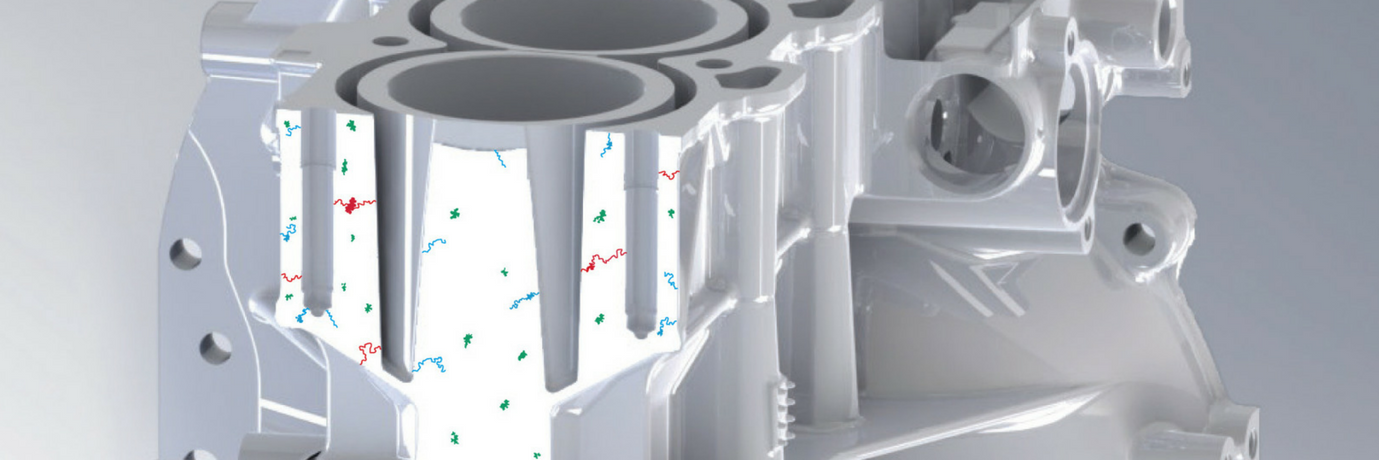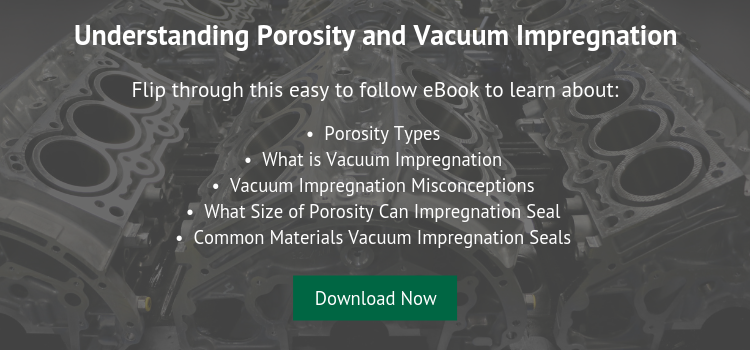Ever since metal casting was first discovered, casting porosity, an area of sponge-like internal structure in an otherwise sound metal part, has been a problem. Porous castings may be caused by internal shrinkage, gas cavitation, oxide films, inclusions and combinations thereof. It can be found in virtually any type of metal casting or part, and is a particular problem in castings made from aluminum, zinc, bronze, iron, magnesium, and other alloys. Porosity is always present in powdered or sintered metal parts because of their structural nature.
Various methods have been used to attempt filling casting porosity openings in parts designed to contain liquids or gases under pressure. One of the first materials used for impregnation was "water-glass" or sodium silicate. In addition to sodium silicate, tung oil, linseed oil, pitch gum and many other materials were used with little success. Shortly after World War II, the development of thermosetting plastics, to be used as impregnants, became an effective and economical means of sealing porosity within the walls of metal castings, especially when used in conjunction with vacuum pressure impregnation techniques.
Understanding Vacuum Impregnation
Vacuum impregnation in metal castings and powdered metal parts refer to the sealing of leaks resulting from porosity. The impregnating sealant, as a liquid, is introduced into the voids or porosity within the wall of the part usually using vacuum and pressure. The sealant is then solidified, filling the porous openings and making the part pressure tight.
Related: Watch How Vacuum Impregnation Seals Porosity
Impregnation of powdered metal parts not only seals parts for pressure applications, but also improves plating or finishing, since bleedout or spotting due to entrapment of plating solutions in the pores is eliminated. Extended tool life is another benefit when machining powdered metal parts.

The part was impregnated prior to coating. If it was not impregnated prior to coating, then coating would breakdown.
When castings have blind or continuous porosity areas, impregnation prior to painting or plating improves and protects the final surface finish from bleedout and blistering.
Impregnation technology seals leaks on all ferrous and nonferrous metals, including die castings, sand castings, investment castings, pressure castings, powdered metal parts as well as forgings or weldments. Iron, bronze, aluminum, zinc, magnesium, steel, sintered metal, as well as alloys of these metals can be impregnated. Other non-metallic materials, such as wood, plastic, and ceramics can also be impregnated.
Related: 3 Reasons to Impregnate Powder Metal Components
Vacuum Impregnation Improves Overall Part Quality
When casting porosity causes leakage problems, "bad" parts are often sorted out by testing and inspection. The "good" parts that are sent to production are often as porous as the "bad" parts, but the porosity is blind and not completely interconnected. Subsequent machining, mechanical or thermal shock, or stress often breaks the thin membrane which keeps the blind porosity from being continuous, thus causing a "leaker". Impregnation fills porosity from both sides preventing leaks even if the membrane does break. Therefore, impregnation improves and enhances quality, while inspection only sorts out leakers.
Economies of Vacuum Impregnation
The value added to metal parts by machining, handling, and assembly may range into the hundreds or even thousands of dollars. This value is lost when a metal part is scrapped because of porosity and leaking. Impregnation costs are small fractions of the costs of remelting, recasting, re-machining and part overruns. Impregnation allows the manufacturer to save time, money, energy and insure quality by salvaging parts which would otherwise have to be rejected. The elimination of scrap and rework substantially increases productivity. In addition, 100% impregnation of metal parts sometimes eliminates the need for expensive leak testing, and often results in a dramatic reduction of field rejects in products such as transmission cases, air-conditioners, pumps and other metal parts.
Related:What is the Cost of Vacuum Impregnation?
Impregnation of powdered metal parts provides the added benefit of prolonged tool life (up to 100 times) because Godfrey & Wing sealants serve as lubricants as well as supporting the individual powered metal particles. Lubricity eliminates the chatter effect during the machining process of unimpregnated powdered metal parts.
Because of the proven effectiveness and economies of impregnation, many engineers specify its use for all types of metal parts that must contain liquids or gases under pressure. It is now common for impregnation processes to be incorporated directly into production schedules to insure quality, rather than to be used strictly as a salvage operation.
Macro and Micro Porosity
There are two general classifications of porosity found in metal parts: macro-porosity in the form of large flaws in the part which may be visible to the naked eye; and micro-porosity in the form of very small, almost invisible voids. In powdered metal parts, the structure of the metal results in a condition similar to macro-porosity in castings having low density, and micro-porosity in high density castings.
Related: 3 Types of Casting Porosity
Porosity can be found as "through, blind or totally enclosed" .
Through porosity (highlighted in red) stretches completely through the wall thickness of a metal part causing a leakage path.
Blind porosity (highlighted in blue) is connected only to one side of the part wall.
Totally enclosed porosity (highlighted in green) is totally isolated within the wall thickness of a part. When castings are machined, both blind and totally enclosed porosity are often "opened up" becoming continuous porosity and causing leaks.

Vacuum Impregnation Process
There are three common methods of impregnation are dry vacuum-pressure, dry vacuum, and wet vacuum.
The most common process is the dry vacuum-pressure process. The steps to the dry vacuum-pressure are:
Step1:
Parts are loaded into a dry impregnation chamber, and the vacuum is applied until a predetermined setpoint is achieved. This vacuum setpoint has been specified in US military specifications to be no less than 29” of mercury (23.4 Torr or 31mbar). There is no liquid present in the vessel to impede air removal from the porosity. All parts see a uniform vacuum pressure. This is the "Dry-Vacuum" portion of the process.
Step2:
When the vacuum end point is reached, the transfer valve is opened. The sealant is de-gased and pulled from the reservoir to the impregnation vessel while the vacuum is maintained.
Step 3:
Next, the vacuum is released, and overpressure is applied (typically between 70-90 PSI). The pressure is then held to allow the sealant to penetrate the porosity. The transfer valve is re-opened and the sealant is transfered back to the storage reservoir. The parts are removed to be washed and cured.
Related: Types of Vacuum Impregnation Processes
Requirements for Sealant
The United States Department of Defense has established military specifications MIL-276A and MIL-I-17563C that outline the requirements for impregnating processes and sealants.
MIL-276A is the military standard for impregnation of porous metal castings and powdered metal components. This standard covers the requirements and tests for the impregnation of structurally sound castings and powder metal components in aluminum, magnesium, copper, iron (excluding steels) and zinc alloys.
MIL-I-17563C is the military standard for impregnation of cast or powder metal components. This standard covers the requirements for impregnants suitable for use in sealing the voids found in cast or powder metal components which cause leaking of contained fluids.
In order to meet the standards required to produce pressure-tight castings, the ideal sealant must be capable of penetrating and filling the porosity and then solidifying completely within the porosity of the metal parts. The sealant should be a polar, low viscosity liquid containing no inert solvents, no filterable solid materials in suspension and producing no gaseous or liquid by-products on curing or transforming into an impervious solid. These properties allow the sealant to penetrate the tiniest openings and deepest recesses of porosity by capillary action. That is, such a sealant can be drawn in by capillary forces, where it may not be possible to push it using hydraulic pressure alone. In addition, a sealant should be stable, have a long pot life, be easy to handle and test without introducing unacceptable health and safety hazards in the work environment.




